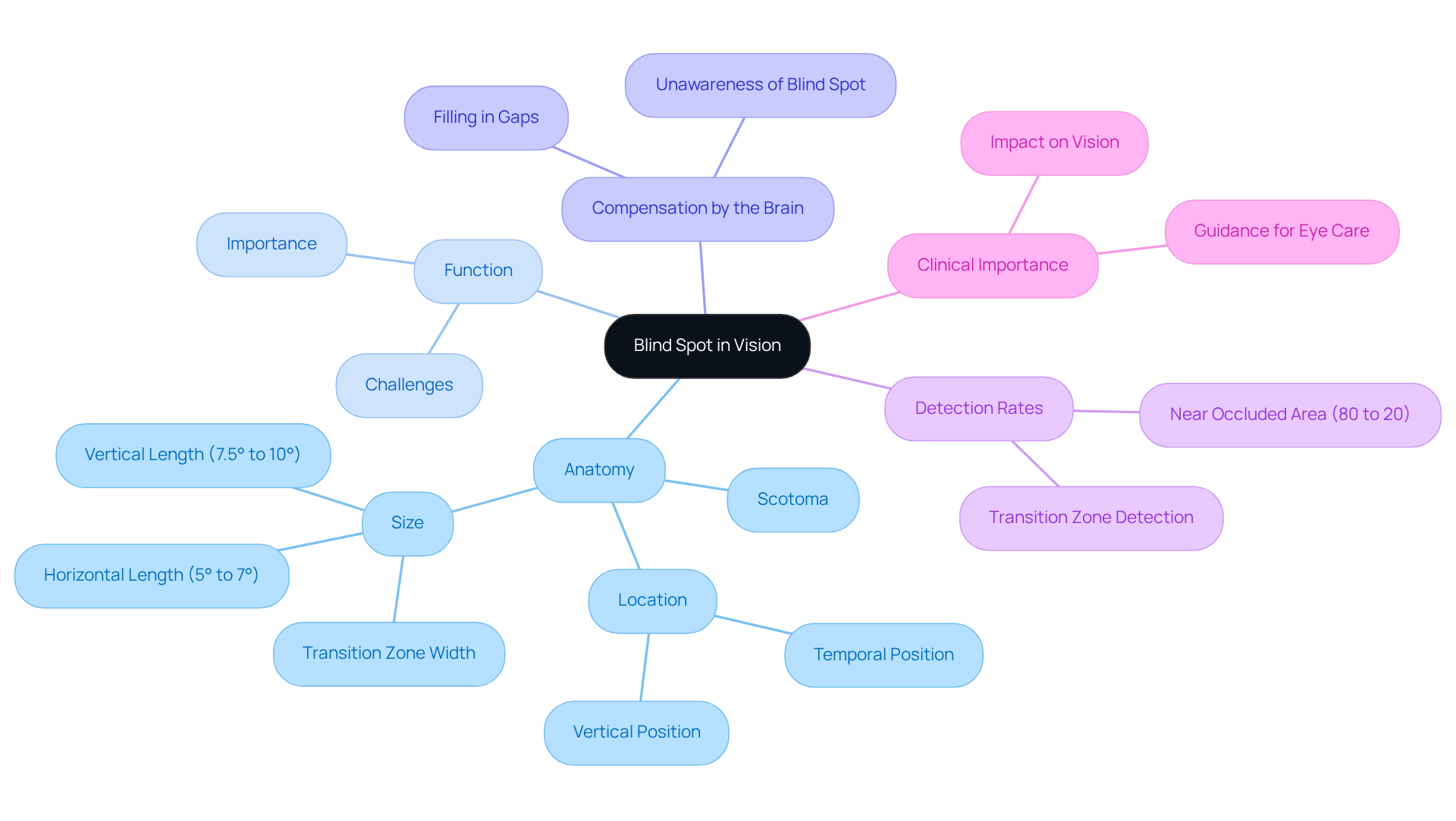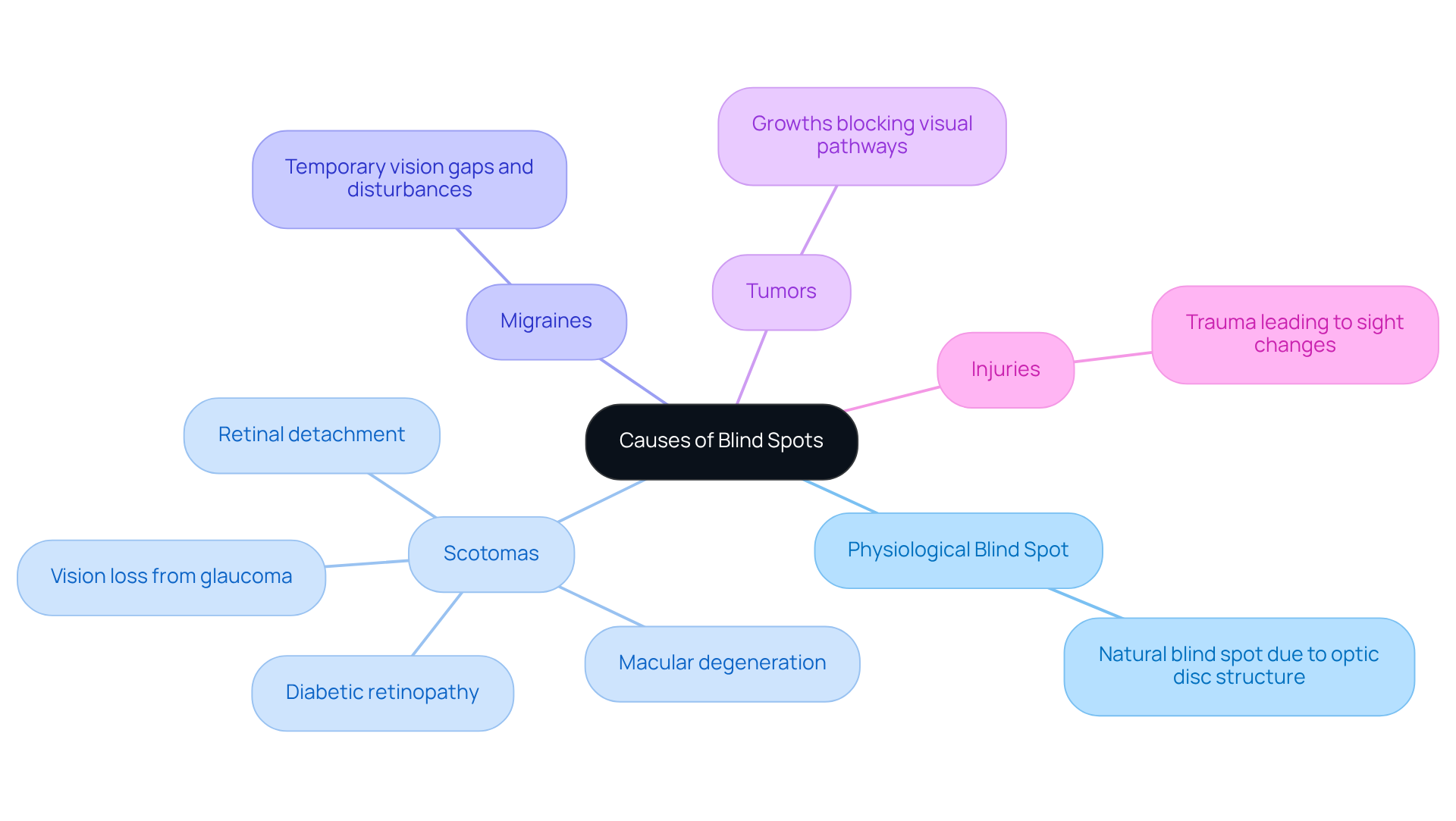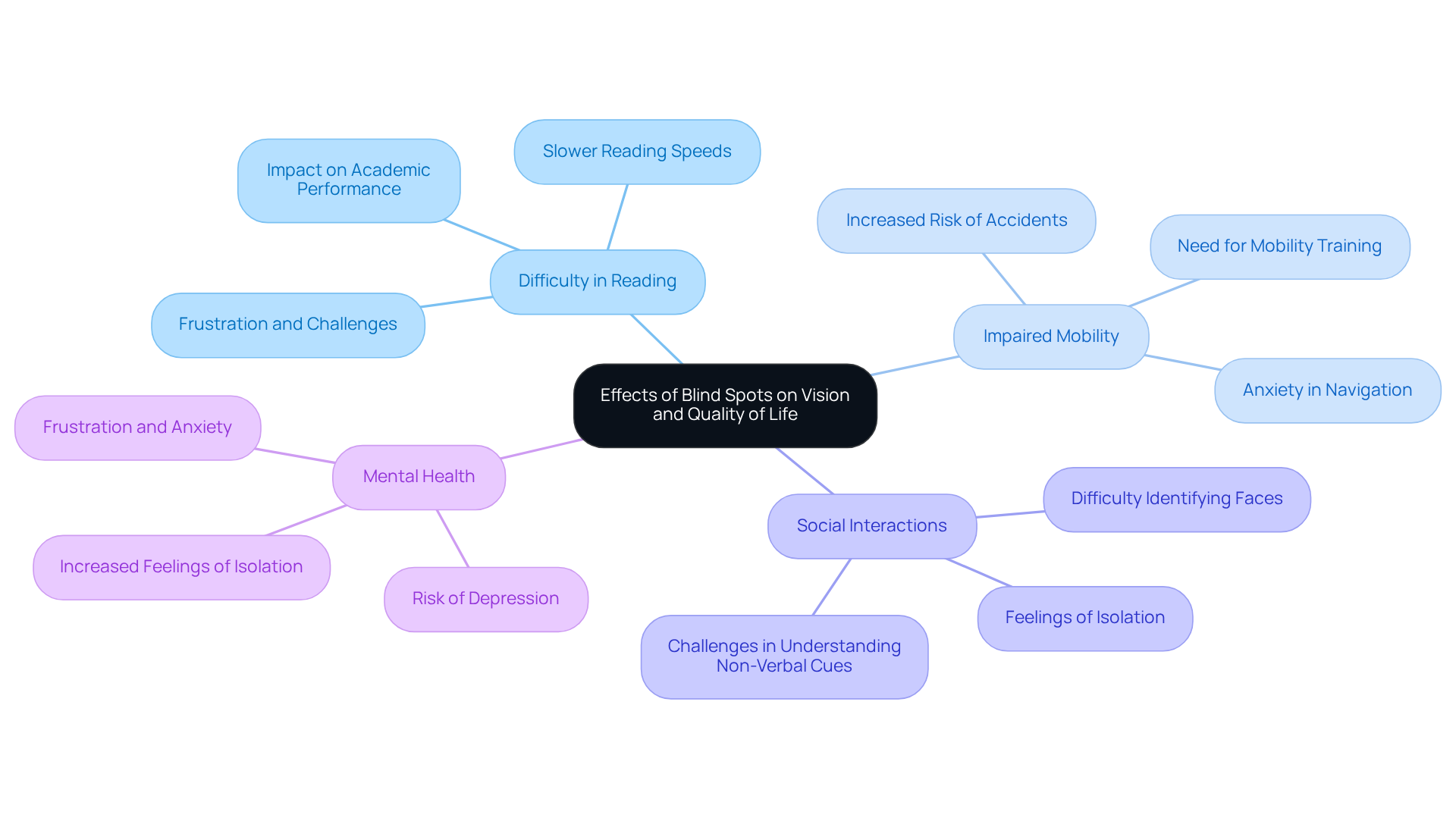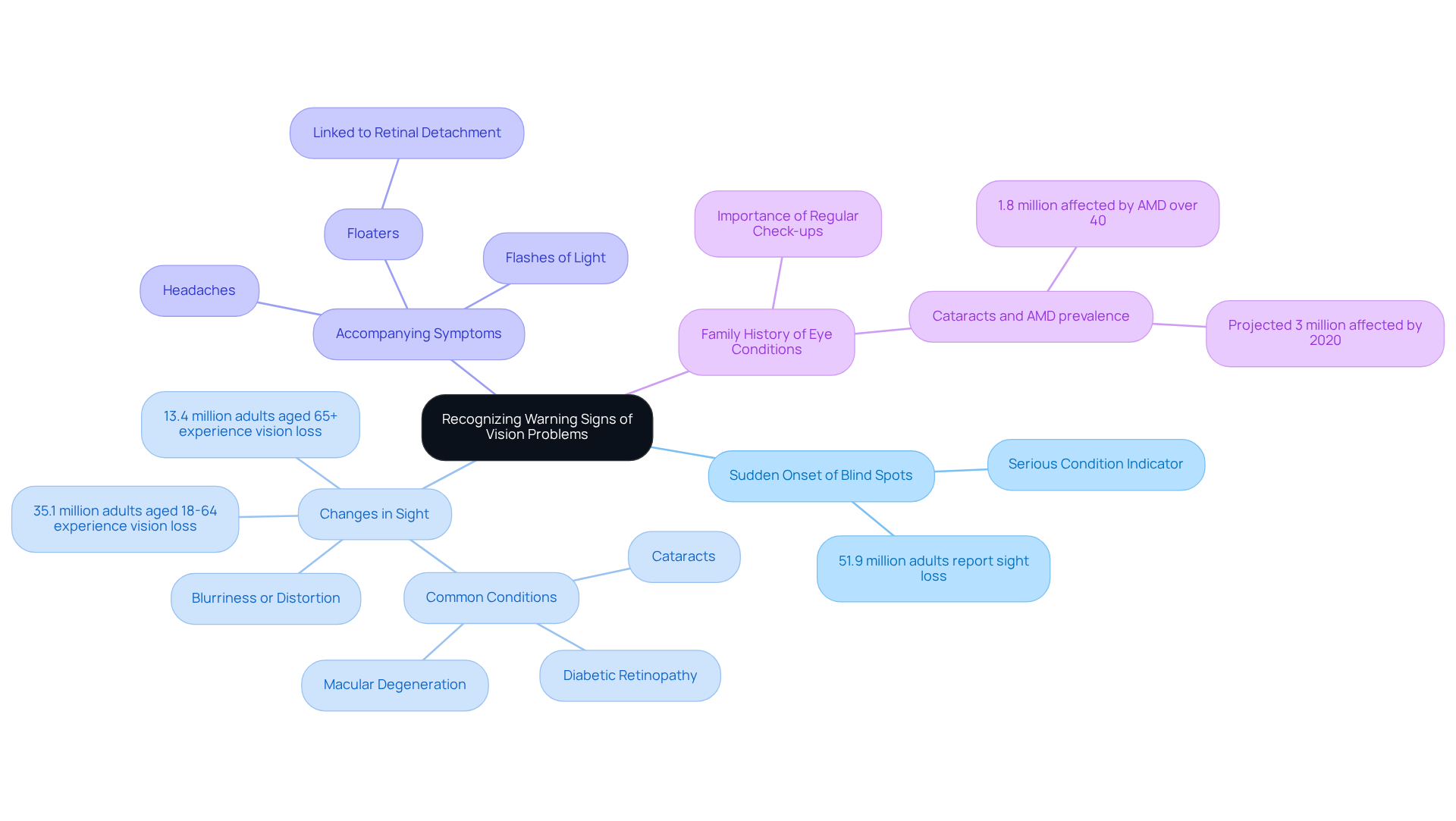Posted by: Northwest Eye in General on July 22, 2025
Overview
This article aims to help you understand the blind spot in your eye, a topic that can bring about feelings of concern. The blind spot occurs naturally due to the absence of photoreceptors at the optic disc. While it might be unsettling to think about, it’s important to know that your brain compensates for this gap, allowing you to maintain normal vision.
However, we understand that various conditions can lead to additional blind areas, which may impact your daily life. This can be a source of worry, and it’s essential to recognize when these changes necessitate medical attention. Remember, you are not alone in this journey, and seeking help is a positive step towards ensuring your well-being.
Introduction
Understanding the intricacies of the human eye reveals a fascinating yet often overlooked aspect: the blind spot. We understand that this natural phenomenon, where the optic nerve exits the eye, creates a small area devoid of vision that many people remain blissfully unaware of. This occurs due to the brain’s remarkable compensatory mechanisms.
However, it’s common to feel concerned if you notice the emergence of blind spots, as they can signal more serious underlying issues. This can lead to significant impacts on daily life and overall well-being.
What are the causes behind these visual gaps, and how can you effectively manage your eye health to mitigate potential risks? We are here to help you through this process.
Define the Blind Spot: Anatomy and Function
The dark area, known as the scotoma, is a specific region in the visual field where image detection is absent due to a lack of photoreceptors. This phenomenon occurs at the optic disc, where the optic nerve exits the eye, leading to a , which results in a natural area of reduced vision. Typically, this area of limited vision is found about 12 to 15 degrees temporally and 1.5 degrees below the horizontal meridian. On the horizontal meridian, can vary in length from 5° to 7°.
We understand that this can be concerning, but it’s important to note that the brain skillfully compensates for this gap, allowing most individuals to remain unaware of it in their daily lives. Comprehending the structure of this , particularly in the eye, is essential for on and identifying issues that may arise from various eye conditions.
Research indicates that the transition from visibility to lack of sight at the edges of the occluded area is gradual, covering approximately 25% of the total width of the region. Detection rates near the occluded area can vary significantly, ranging from 80% to 20% within these transition zones. This highlights the complexity of visual perception and the brain’s remarkable ability to fill in gaps in our visual field.
Additionally, studies suggest that the occluded area is much larger than the foveola, underscoring its importance in the realm of vision. and is crucial, especially for individuals experiencing . It can guide about potential concerns and treatment options.
As Annegret Meermeier observes, ‘The hidden area is both a necessity and a nuisance for vision,’ emphasizing its dual role in our visual experience. We are here to help you through this process and ensure you feel supported every step of the way.

Identify Causes of Blind Spots: From Anatomy to Disease
Blind areas can develop in the form of a due to various anatomical and pathological factors, and we understand that this can be concerning. :
- Physiological Blind Spot: This is a natural blind spot present in everyone due to the structure of the optic disc.
- Scotomas: These are unusual , also referred to as a blind spot in the eye, that may arise from conditions like , macular degeneration, diabetic retinopathy, and retinal detachment. Such conditions can damage the retina or optic nerve, leading to visual field defects.
- Migraines: Ocular migraines can create or , often accompanied by headaches. It’s common to feel anxious during these episodes.
- Tumors: Growths in or near the optic nerve can block visual pathways, resulting in areas of lost vision. We know this can be alarming.
- Injuries: Trauma to the eye or head can lead to sudden changes in sight, including the appearance of dark areas.
is vital for understanding when to seek medical attention. We are here to help you through this process and effectively.

Assess Effects of Blind Spots: Impact on Vision and Quality of Life
Obscured areas can significantly impact a person’s sight and overall quality of life. We understand that the consequences of these are multifaceted and can include:
- Difficulty in Reading: , making reading not only challenging but also frustrating. Studies indicate that than their sighted peers, which can hinder academic performance and literacy development.
- Impaired Mobility: It’s common to feel anxious about navigation, particularly in unfamiliar environments. Individuals with blind areas may struggle, leading to an increased risk of accidents or falls. This highlights the and environmental adaptations to enhance safety.
- Social Interactions: or understand non-verbal signals, which are essential for successful social engagement. This limitation may lead to feelings of isolation and difficulty in forming relationships, as individuals may miss out on important social cues.
- Mental Health: The frustration and anxiety arising from sight issues can significantly decrease quality of life. Individuals may experience , contributing to mental health challenges such as depression or anxiety.
for individuals experiencing blind spots, as it underscores the importance of seeking appropriate care and intervention. At Northwest Eye, we believe that empowering patients through knowledge is key to better . Our Be Eye Wise initiative encourages individuals to understand their eye conditions and the available treatment options. Prompt identification and customized assistance can alleviate these difficulties, improving both perspective and overall well-being.
Take the Next Step: We invite you to schedule an appointment with our dedicated team to learn more about your eye health and how we can assist you. Consider taking our LASIK Self-Test to determine if you are a candidate for , which could significantly enhance your sight and quality of life.
- “Great place. The doctors and staff were extremely patient with our very active 15 months old Daughter.” – Lydea L
- “All of the staff at Northwest Eye are friendly and get your needs taken care of in the best of ways. A visit to any of the clinics is a great experience.” – Perry H
- “Always professional, prompt and helpful with explanations and procedures.” – Mary Ann M

Determine When to Seek Help: Recognizing Warning Signs
Recognizing the warning signs of vision problems is essential for maintaining your eye health. If you experience any of the following symptoms, we urge you to seek medical attention promptly:
- Sudden Onset of Blind Spots: The appearance of new or can signal a serious condition that requires immediate evaluation. It’s important to note that nearly 51.9 million American adults report experiencing some level of sight loss, highlighting the prevalence of such issues.
- Changes in Sight: , including blurriness or distortion, should prompt a visit to an eye care professional. , such as nearsightedness, farsightedness, or serious conditions like , diabetic retinopathy, and macular degeneration. Approximately 35.1 million adults aged 18 to 64 and 13.4 million adults aged 65 and older experience a decline in sight, underscoring the need for vigilance regarding changes in eyesight.
- Accompanying Symptoms: We understand that , especially when occurring alongside a blind spot in the eye, may indicate underlying issues that require attention. For instance, the presence of floaters can be linked to conditions like retinal detachment, which necessitates urgent care. Symptoms left untreated can lead to serious health complications, so it’s vital to seek professional help immediately.
- Family History of : If you have a , regular check-ups become even more critical to monitor your eye health. With a significant number of individuals affected by and age-related macular degeneration, proactive management is vital. In fact, over 40, with projections indicating nearly 3 million will be affected by 2020.
By recognizing these signs and acting promptly, you can facilitate early diagnosis and treatment, ultimately preserving your vision and enhancing your quality of life. Remember, only a doctor or eye care professional can offer an accurate diagnosis around any symptom you may be experiencing. If you are experiencing any of these symptoms, we are here to help you through this process—schedule an appointment with Northwest Eye for a comprehensive evaluation.

Conclusion
Understanding the complexities of the blind spot in the eye reveals its dual nature as both a natural phenomenon and a potential source of concern. We understand that this can be a troubling topic, but it’s important to know that you’re not alone. This article has explored the anatomy and function of the blind spot, delving into its causes, effects, and the importance of proper eye care. Recognizing that everyone has a physiological blind spot while also being aware of the pathological conditions that can lead to additional blind spots is crucial for maintaining optimal eye health.
Key points discussed include the various causes of blind spots, such as:
- Scotomas from eye diseases
- The impact of ocular migraines
- The effects of tumors and injuries
It’s common to feel overwhelmed by these visual impairments, which can hinder daily activities, from reading and mobility to social interactions and mental health. Understanding these effects emphasizes the necessity of seeking timely medical attention when experiencing warning signs, such as sudden changes in vision or accompanying symptoms. Remember, seeking help is a sign of strength.
Ultimately, awareness and education are vital in addressing issues related to blind spots. By empowering individuals to recognize symptoms and seek help, the significance of early intervention in preserving vision and enhancing quality of life becomes evident. We encourage you to take proactive steps, such as scheduling regular eye exams and discussing any concerns with healthcare professionals. These actions can lead to better outcomes and a more fulfilling life despite the challenges posed by blind spots. We are here to help you through this process.
Frequently Asked Questions
What is the blind spot in the eye?
The blind spot, also known as the scotoma, is a specific region in the visual field where image detection is absent due to a lack of photoreceptors. It occurs at the optic disc, where the optic nerve exits the eye.
Where is the blind spot located in relation to the visual field?
The blind spot is typically found about 12 to 15 degrees temporally and 1.5 degrees below the horizontal meridian. On the horizontal meridian, the occluded area can vary in length from 5° to 7°.
How does the brain compensate for the blind spot?
The brain skillfully compensates for the blind spot, allowing most individuals to remain unaware of it in their daily lives. It fills in gaps in the visual field, making the absence of sight less noticeable.
What is the transition from visibility to lack of sight in the blind spot?
The transition from visibility to lack of sight at the edges of the occluded area is gradual, covering approximately 25% of the total width of the region. Detection rates near the occluded area can range from 80% to 20%.
How does the size of the occluded area compare to the foveola?
Research indicates that the occluded area is much larger than the foveola, highlighting its significance in the realm of vision.
Why is understanding the blind spot important for individuals with vision difficulties?
Understanding the structure and role of the blind spot is crucial for individuals experiencing vision difficulties, as it can guide discussions with eye care specialists about potential concerns and treatment options.
What did Annegret Meermeier say about the hidden area of vision?
Annegret Meermeier stated, “The hidden area is both a necessity and a nuisance for vision,” emphasizing its dual role in our visual experience.






